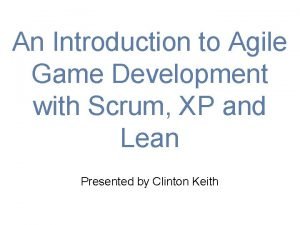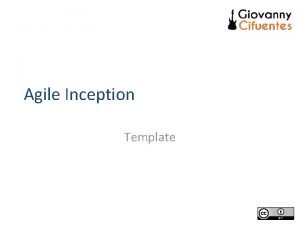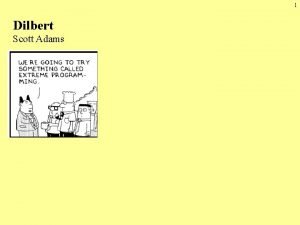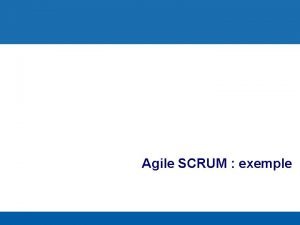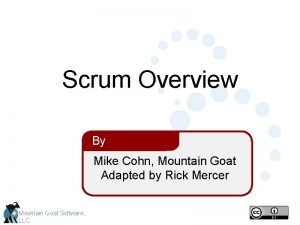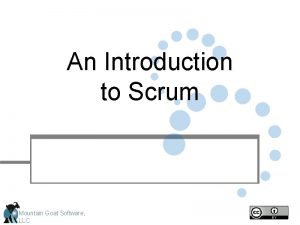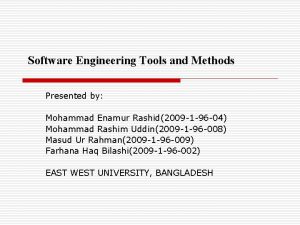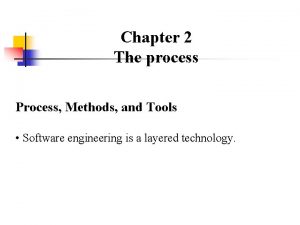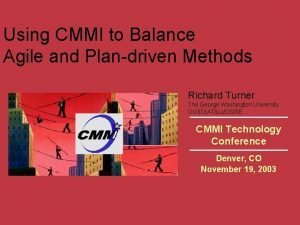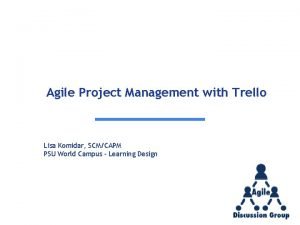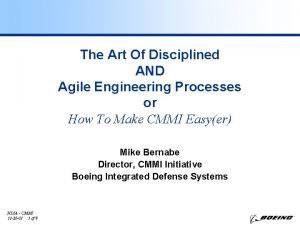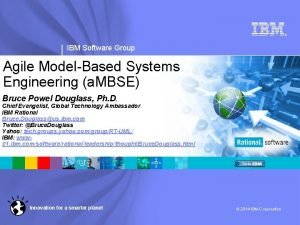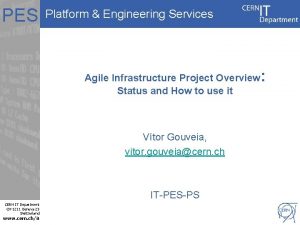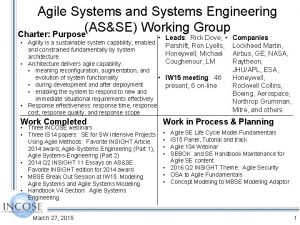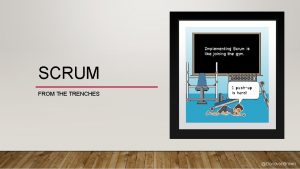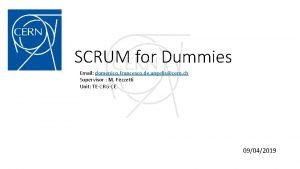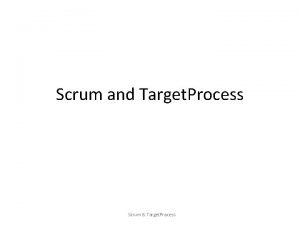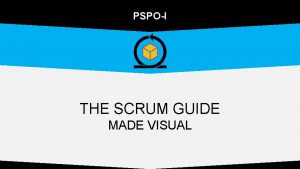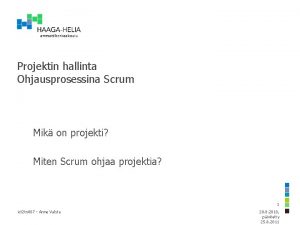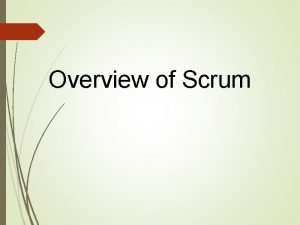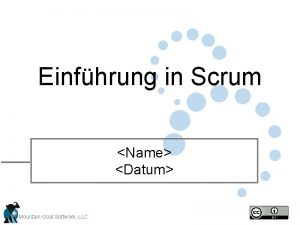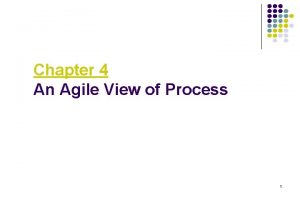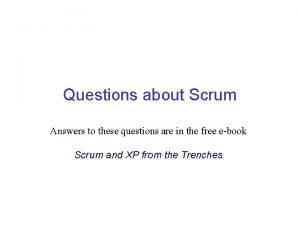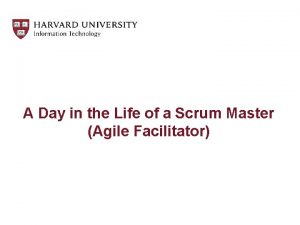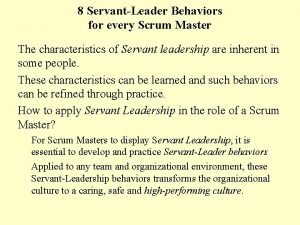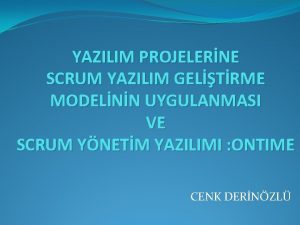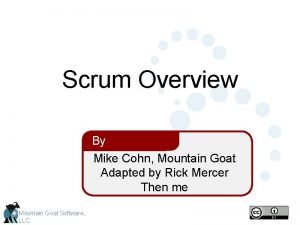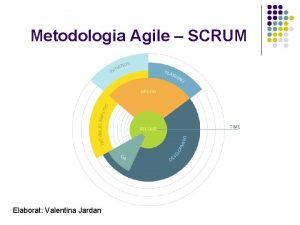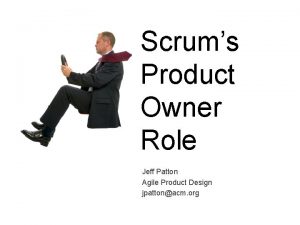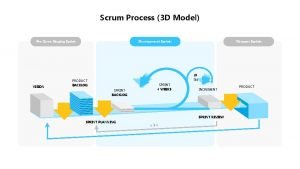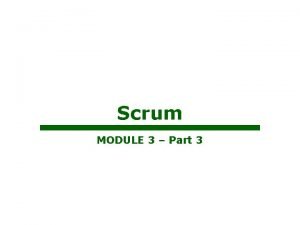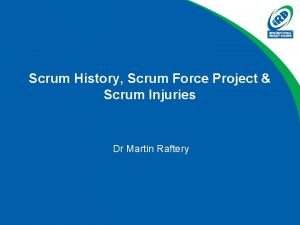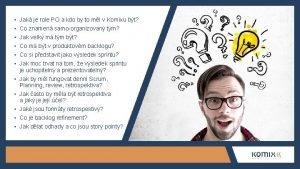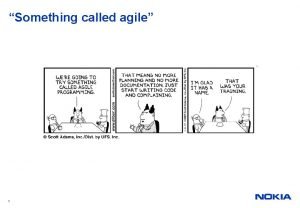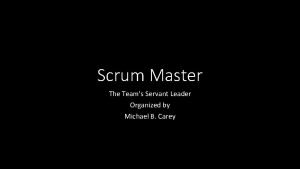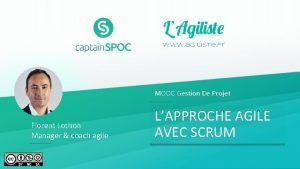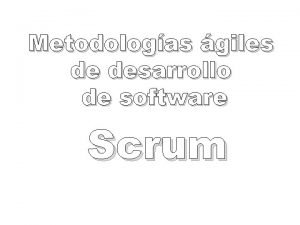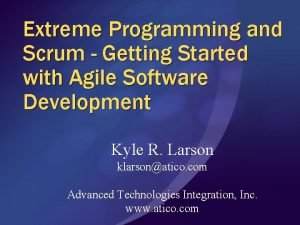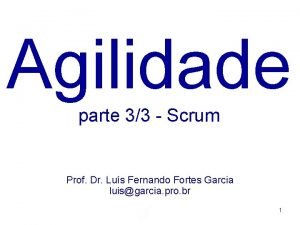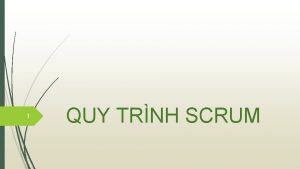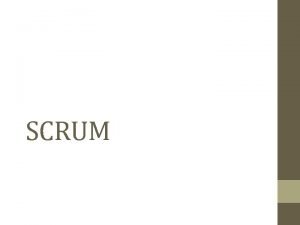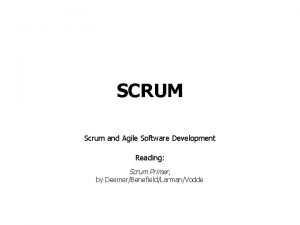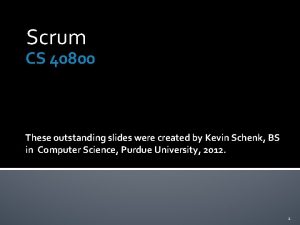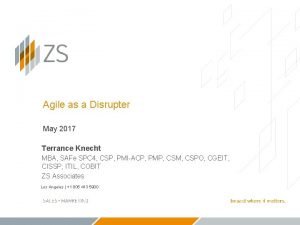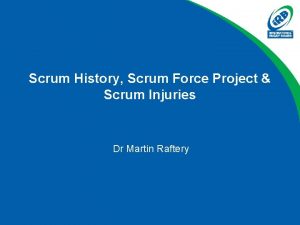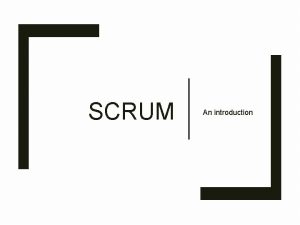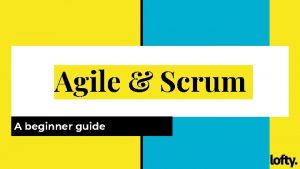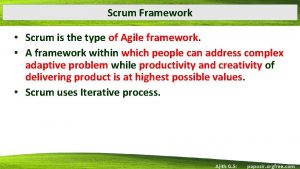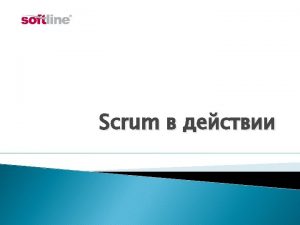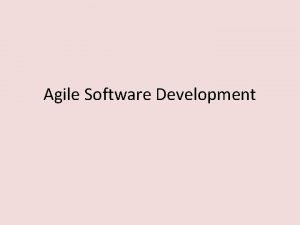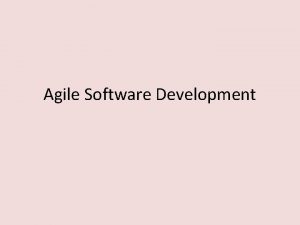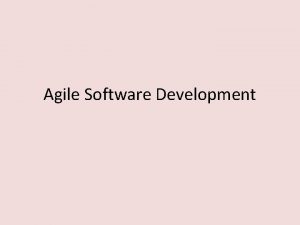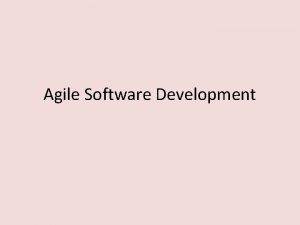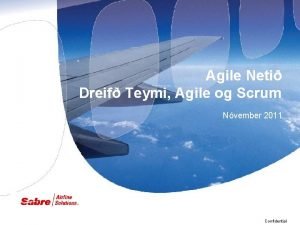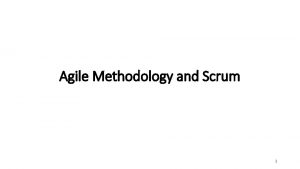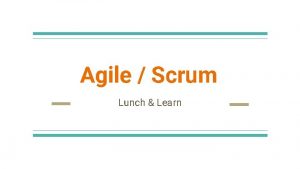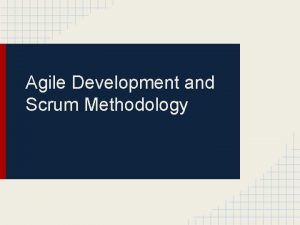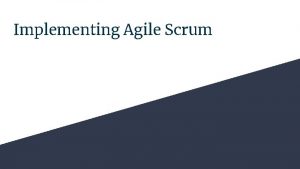Software Engineering Scrum Agile Software Engineering Agile methods


































































- Slides: 66

軟體 程 (Software Engineering) 敏捷軟體 程: 敏捷方法、Scrum、 極限程式設計 (Agile Software Engineering: Agile methods, Scrum, and Extreme Programming) 1091 SE 03 MBA, IM, NTPU (M 5118) (Fall 2020) Tue 2, 3, 4 (9: 10 -12: 00) (B 8 F 40) Min-Yuh Day 戴敏育 Associate Professor 副教授 Institute of Information Management, National Taipei University 國立臺北大學 資訊管理研究所 https: //web. ntpu. edu. tw/~myday 2020 -09 -29 1

課程大綱 (Syllabus) 週次 (Week) 日期 (Date) 內容 (Subject/Topics) 1 2020/09/15 軟體 程概論 (Introduction to Software Engineering) 2 2020/09/22 軟體產品與專案管理:軟體產品管理,原型設計 (Software Products and Project Management: Software product management and prototyping) 3 2020/09/29 敏捷軟體 程:敏捷方法、Scrum、極限程式設計 (Agile Software Engineering: Agile methods, Scrum, and Extreme Programming) 4 2020/10/06 功能、場景和故事 (Features, Scenarios, and Stories) 5 2020/10/13 軟體架構:架構設計、系統分解、分散式架構 (Software Architecture: Architectural design, System decomposition, and Distribution architecture) 6 2020/10/20 軟體 程個案研究 I (Case Study on Software Engineering I) 2

課程大綱 (Syllabus) 週次 (Week) 日期 (Date) 內容 (Subject/Topics) 7 2020/10/27 基於雲的軟體:虛擬化和容器、軟體即服務 (Cloud-Based Software: Virtualization and containers, Everything as a service, Software as a service) 8 2020/11/03 雲端運算與雲軟體架構 (Cloud Computing and Cloud Software Architecture) 9 2020/11/10 期中報告 (Midterm Project Report) 10 2020/11/17 微服務架構:RESTful服務、服務部署 (Microservices Architecture, RESTful services, Service deployment) 11 2020/11/24 軟體 程產業實務 (Industry Practices of Software Engineering) 12 2020/12/01 安全和隱私 (Security and Privacy) 3

課程大綱 (Syllabus) 週次 (Week) 日期 (Date) 內容 (Subject/Topics) 13 2020/12/08 軟體 程個案研究 II (Case Study on Software Engineering II) 14 2020/12/15 可靠的程式設計 (Reliable Programming) 15 2020/12/22 測試:功能測試、測試自動化、 測試驅動的開發、程式碼審查 (Testing: Functional testing, Test automation, Test-driven development, and Code reviews) 16 2020/12/29 Dev. Ops和程式碼管理: 程式碼管理和Dev. Ops自動化 (Dev. Ops and Code Management: Code management and Dev. Ops automation) 17 2021/01/05 期末報告 I (Final Project Report I) 18 2021/01/12 期末報告 II (Final Project Report I) 4

Agile Software Engineering 5

Software Engineering and Project Management Analyze Design Build Test Deliver Requirements definition System and Software design Implementation Integration and system testing Operation and maintenance and unit testing Project Management 6

Software execution models Stand-alone execution Hybrid execution Software as a service User’s computer User interface Product functionality User data User interface Partial functionality User data User interface (browser or app) Product updates Additional functionality User data backups Product updates Product functionality User data Vendor’s servers Source: Ian Sommerville (2019), Engineering Software Products: An Introduction to Modern Software Engineering, Pearson. 7

Product management concerns Business needs Product manager Technology constraints Customer experience Source: Ian Sommerville (2019), Engineering Software Products: An Introduction to Modern Software Engineering, Pearson. 8

Technical interactions of product managers Product vision management Product backlog management Product manager Acceptance testing User stories and scenarios Customer testing User interface design Source: Ian Sommerville (2019), Engineering Software Products: An Introduction to Modern Software Engineering, Pearson. 9

Software Development Life Cycle (SDLC) The waterfall model Requirements definition System and Software design Implementation and unit testing Integration and system testing Operation and maintenance Source: Ian Sommerville (2015), Software Engineering, 10 th Edition, Pearson. 10

Incremental development Concurrent activities Outline description Specification Initial version Development Intermediate versions Validation Final version Source: Ian Sommerville (2015), Software Engineering, 10 th Edition, Pearson. 11

Reuse-oriented software engineering Software discovery Requirements specification Application system available Requirements refinement Software evaluation Configure application system Adapt components Integrate system Components available Develop new components Source: Ian Sommerville (2015), Software Engineering, 10 th Edition, Pearson. 12

Prototype development Establish prototype objectives Define prototype functionality Develop prototype Evaluate prototype Prototyping plan Outline definition Executable Prototyping Evaluation report Source: Ian Sommerville (2015), Software Engineering, 10 th Edition, Pearson. 13

Incremental delivery Define outline requirements Assign requirements to increments Design system architecture Develop system increment System incomplete ? Validate increment Integrate increment Validate system Deploy increment System complete ? Final system Source: Ian Sommerville (2015), Software Engineering, 10 th Edition, Pearson. 14

The process improvement model Process Measure Process Change Process Analyze Source: Ian Sommerville (2015), Software Engineering, 10 th Edition, Pearson. 15

Capability maturity levels Level 5 Optimizing Level 4 Quantitatively Defined Level 3 Defined Level 2 Managed Level 1 Initial Source: Ian Sommerville (2015), Software Engineering, 10 th Edition, Pearson. 16

Plan-based and Agile development Plan-based development Requirements specification Requirements engineering Design and implementation Requirements change requests Agile development Requirements engineering Design and implementation Source: Ian Sommerville (2015), Software Engineering, 10 th Edition, Pearson. 17

Uncertainty and Complexity Model High Uncertainty ex pl m Co s ao Ch Fundamentally risky Adaptive approaches work well here te d Linear approaches work well here pl m e Low Uncertainty ica pl m Co Si Requirements Uncertainty Inspired by the Stacey Complexity Model Low Uncertainty High Uncertainty Technical Degree of Uncertainty Source: Project Management Institute (2017), Agile Practice Guide, Project Management Institute 18

Characteristics of Four Categories of Life Cycles Approach Requirements Activities Delivery Goal Predictive Fixed Performed once for the entire project Single delivery Manage cost Iterative Dynamic Repeated until correct Single delivery Correctness of solution Incremental Dynamic Agile Dynamic Performed once for Frequent smaller a given increment deliveries Repeated until correct Frequent smaller deliveries Source: Project Management Institute (2017), Agile Practice Guide, Project Management Institute Speed Customer value via frequent deliveries and feedback 19

Incremental Agile Low Frequency of Delivery High The Continuum of Life Cycles Predictive Low Iterative Degree of Change Source: Project Management Institute (2017), Agile Practice Guide, Project Management Institute High 20

Predictive Life Cycle Analyze Design Build Test Source: Project Management Institute (2017), Agile Practice Guide, Project Management Institute Deliver 21

Iterative Life Cycle Analyze Prototype Refine Analyze Design Build Test Source: Project Management Institute (2017), Agile Practice Guide, Project Management Institute Deliver 22

A Life Cycle of Varying-Sized Increments Analyze Design Build Test Deliver Source: Project Management Institute (2017), Agile Practice Guide, Project Management Institute 23

Iteration-Based and Flow-Based Agile Life Cycles Iteration-Based Agile Requirements Analysis Design Build Test Repeat as needed … Requirements Analysis Design Build Test Flow-Based Agile Requirements Analysis Design Build Test the number of features in the WIP limit Requirements Analysis Design Repeat Build as needed Test … the number of features in the WIP limit Source: Project Management Institute (2017), Agile Practice Guide, Project Management Institute Requirements Analysis Design Build Test the number of features in the WIP limit 24

Agile 25

Agile software engineering • Software products must be brought to market quickly so rapid software development and delivery is essential. • Virtually all software products are now developed using an agile approach. • Agile software engineering focuses on delivering functionality quickly, responding to changing product specifications and minimizing development overheads. Source: Ian Sommerville (2019), Engineering Software Products: An Introduction to Modern Software Engineering, Pearson. 26

Agile Manifesto Values, Principles, and Common Practices Agile Mindset 4 12 Values Principles Practices Source: Project Management Institute (2017), Agile Practice Guide, Project Management Institute 27

Agile is a Blanket Term for Many Approaches Lean Agile Kanban Scrum. Ban Scrum Crystal XP FDD AUP DSDM Source: Project Management Institute (2017), Agile Practice Guide, Project Management Institute 28

Agile Manifesto and Mindset Agile is a mindset defined by 4 values, guided by 12 principles, and manifested through many different practices. Agile practitioners select practices based on their needs. Source: Project Management Institute (2017), Agile Practice Guide, Project Management Institute 29

The Four Values of the Agile Manifesto (Manifesto for Agile Software Development, 2001) We are uncovering better ways of developing software by doing it and helping others do it. Through this work we have come to value: 1. individuals and interactions over processes and tools 2. working software over comprehensive documentation 3. customer collaboration over contract negotiation 4. responding to change over following a plan That is, while there is value in the items on the right, we value the items on the left more. Source: Ian Sommerville (2019), Engineering Software Products: An Introduction to Modern Software Engineering, Pearson. 30

The Twelve Principles Behind the Agile Manifesto 1. Our highest priority is to satisfy the customer through early and continuous delivery of valuable software. 2. Welcome changing requirements, even late in development. Agile processes harness change for the customer’s competitive advantage. 3. Deliver working software frequently, from a couple of weeks to a couple of months, with a preference to the shorter timescale. 4. Business people and developers must work together daily throughout the project. 5. Build projects around motivated individuals. Give them the environment and support they need, and trust them to get the job done. 6. The most efficient and effective method of conveying information to and within a development team is face-to-face conversation. Source: Project Management Institute (2017), Agile Practice Guide, Project Management Institute 31

The Twelve Principles Behind the Agile Manifesto 7. Working software is the primary measure of progress. 8. Agile processes promote sustainable development. The sponsors, developers, and users should be able to maintain a constant pace indefinitely. 9. Continuous attention to technical excellence and good design enhances agility. 10. Simplicity—the art of maximizing the amount of work not done —is essential. 11. The best architectures, requirements, and designs emerge from self-organizing teams. 12. At regular intervals, the team reflects on how to become more effective, then tunes and adjusts its behavior accordingly. Source: Project Management Institute (2017), Agile Practice Guide, Project Management Institute 32

Agile Development Principles • Involve the customer Involve customers closely with the software development team. Their role is to provide and prioritize new system requirements and to evaluate each increment of the system. • Embrace change Expect the features of the product and the details of these features to change as the development team and the product manager learn more about it. Adapt the software to cope with changes as they are made. • Develop and deliver incrementally Always develop software products in increments. Test and evaluate each increment as it is developed and feed back required changes to the development team. Source: Ian Sommerville (2019), Engineering Software Products: An Introduction to Modern Software Engineering, Pearson. 33

Agile Development Principles • Maintain simplicity Focus on simplicity in both the software being developed and in the development process. Wherever possible, do what you can to eliminate complexity from the system. • Focus on people, not things Trust the development team and do not expect everyone to always do the development process in the same way. Team members should be left to develop their own ways of working without being limited by prescriptive software processes. Source: Ian Sommerville (2019), Engineering Software Products: An Introduction to Modern Software Engineering, Pearson. 34

Agile software engineering • A large number of ‘agile methods’ have been developed. – There is no ‘best’ agile method or technique. – It depends on who is using the technique, the development team and the type of product being developed Source: Ian Sommerville (2019), Engineering Software Products: An Introduction to Modern Software Engineering, Pearson. 35

Agile methods • Plan-driven development evolved to support the engineering of large, long-lifetime systems – This approach is based on controlled and rigorous software development processes that include detailed project planning, requirements specification and analysis and system modelling. – However, plan-driven development involves significant overheads and documentation and it does not support the rapid development and delivery of software. • Agile methods were developed in the 1990 s to address this problem. – These methods focus on the software rather than its documentation, develop software in a series of increments and aim to reduce process bureaucracy as much as possible. Source: Ian Sommerville (2019), Engineering Software Products: An Introduction to Modern Software Engineering, Pearson. 36

Incremental development • All agile methods are based around incremental development and delivery. • Product development focuses on the software features, where a feature does something for the software user. • With incremental development, you start by prioritizing the features so that the most important features are implemented first. – You only define the details of the feature being implemented in an increment. – That feature is then implemented and delivered. • Users or surrogate users can try it out and provide feedback to the development team. You then go on to define and implement the next feature of the system. Source: Ian Sommerville (2019), Engineering Software Products: An Introduction to Modern Software Engineering, Pearson. 37

Incremental development Product feature list If all features are complete, deliver system release 1 Choose features to be included in increment 2 5 Refine features descriptions Deliver system increment 4 Integrate feature into system 3 Implement and test feature Source: Ian Sommerville (2019), Engineering Software Products: An Introduction to Modern Software Engineering, Pearson. 38

Incremental development activities 1. Choose features to be included in an increment Using the list of features in the planned product, select those features that can be implemented in the next product increment. 2. Refine feature descriptions Add detail to the feature descriptions so that the team have a common understanding of each feature and there is sufficient detail to begin implementation. 3. Implement and test Implement the feature and develop automated tests for that feature that show that its behaviour is consistent with its description. 4. Integrate feature and test Integrate the developed feature with the existing system and test it to check that it works in conjunction with other features. 5. Deliver system increment Deliver the system increment to the customer or product manager for checking and comments. If enough features have been implemented, release a version of the system for customer use. Source: Ian Sommerville (2019), Engineering Software Products: An Introduction to Modern Software Engineering, Pearson. 39

Extreme programming • The most influential work that has changed software development culture was the development of Extreme Programming (XP). • The name was coined by Kent Beck in 1998 because the approach was developed by pushing recognized good practice, such as iterative development, to ‘extreme’ levels. • Extreme programming focused on 12 new development techniques that were geared to rapid, incremental software development, change and delivery. • Some of these techniques are now widely used; others have been less popular. Source: Ian Sommerville (2019), Engineering Software Products: An Introduction to Modern Software Engineering, Pearson. 40

Extreme Programming Practices Test-first development Continuous integration Incremental planning Collective ownership Refactoring Extreme Programming (XP) Pair programming Small releases Simple design On-site customer Sustainable pace Source: Ian Sommerville (2019), Engineering Software Products: An Introduction to Modern Software Engineering, Pearson. 41

Widely adopted XP practices • Incremental planning/user stories – There is no ‘grand plan’ for the system. Instead, what needs to be implemented (the requirements) in each increment are established in discussions with a customer representative. – The requirements are written as user stories. – The stories to be included in a release are determined by the time available and their relative priority. Source: Ian Sommerville (2019), Engineering Software Products: An Introduction to Modern Software Engineering, Pearson. 42

Widely adopted XP practices • Small releases – The minimal useful set of functionality that provides business value is developed first. – Releases of the system are frequent and incrementally add functionality to the previous release. Source: Ian Sommerville (2019), Engineering Software Products: An Introduction to Modern Software Engineering, Pearson. 43

Widely adopted XP practices • Test-driven development – Instead of writing code then tests for that code, developers write the tests first. – This helps clarify what the code should actually do and that there is always a ‘tested’ version of the code available. – An automated unit test framework is used to run the tests after every change. – New code should not ‘break’ code that has already been implemented. Source: Ian Sommerville (2019), Engineering Software Products: An Introduction to Modern Software Engineering, Pearson. 44

Widely adopted XP practices • Continuous integration – As soon as the work on a task is complete, it is integrated into the whole system and a new version of the system is created. – All unit tests from all developers are run automatically and must be successful before the new version of the system is accepted. Source: Ian Sommerville (2019), Engineering Software Products: An Introduction to Modern Software Engineering, Pearson. 45

Widely adopted XP practices • Refactoring – Refactoring means improving the structure, readability, efficiency and security of a program. – All developers are expected to refactor the code as soon as potential code improvements are found. – This keeps the code simple and maintainable. Source: Ian Sommerville (2019), Engineering Software Products: An Introduction to Modern Software Engineering, Pearson. 46

Widely adopted XP practices • Incremental planning/user stories – There is no ‘grand plan’ for the system. Instead, what needs to be implemented (the requirements) in each increment are established in discussions with a customer representative. – The requirements are written as user stories. – The stories to be included in a release are determined by the time available and their relative priority. Source: Ian Sommerville (2019), Engineering Software Products: An Introduction to Modern Software Engineering, Pearson. 47

Scrum • Software company managers need information that will help them understand how much it costs to develop a software product, how long it will take and when the product can be brought to market. • Plan-driven development provides this information through long-term development plans that identify deliverables - items the team will deliver and when these will be delivered. • Plans always change so anything apart from short-term plans are unreliable. • Scrum is an agile method that provides a framework for agile project organization and planning. It does not mandate any specific technical practices. Source: Ian Sommerville (2019), Engineering Software Products: An Introduction to Modern Software Engineering, Pearson. 48

Scrum Terminology • Scrum A daily team meeting where progress is reviewed and work to be done that day as discussed and agreed. • Sprint A short period, typically two to four weeks, when a product increment is developed. • Scrum. Master A team coach who guides the team in the effective use of Scrum. Source: Ian Sommerville (2019), Engineering Software Products: An Introduction to Modern Software Engineering, Pearson. 49

Scrum Terminology • Product The software product that is being developed by the Scrum team. • Product owner A team member who is responsible for identifying product features and attributes. They review work done and help to test the product. • Product backlog A to-do list of items such as bugs, features and product improvements that the Scrum team have not yet completed. Source: Ian Sommerville (2019), Engineering Software Products: An Introduction to Modern Software Engineering, Pearson. 50

Scrum Terminology • Development team A small self-organising team of five to eight people who are responsible for developing the product. • Potentially shippable product increment The output of a sprint which should be of high enough quality to be deployed for customer use. • Velocity An estimate of how much work a team can do in a single sprint. Source: Ian Sommerville (2019), Engineering Software Products: An Introduction to Modern Software Engineering, Pearson. 51

Key roles in Scrum • The Product Owner is responsible for ensuring that the development team are always focused on the product they are building rather than diverted into technically interesting but less relevant work. – In product development, the product manager should normally take on the Product Owner role. • The Scrum. Master is a Scrum expert whose job is to guide the team in the effective use of the Scrum method. The developers of Scrum emphasize that the Scrum. Master is not a conventional project manager but is a coach for the team. They have authority within the team on how Scrum is used. – In many companies that use Scrum, the Scrum. Master also has some project management responsibilities. Source: Ian Sommerville (2019), Engineering Software Products: An Introduction to Modern Software Engineering, Pearson. 52

Scrum and sprints • In Scrum, software is developed in sprints, which are fixed-length periods (2 - 4 weeks) in which software features are developed and delivered. • During a sprint, the team has daily meetings (Scrums) to review progress and to update the list of work items that are incomplete. • Sprints should produce a ‘shippable product increment’. This means that the developed software should be complete and ready to deploy. Source: Ian Sommerville (2019), Engineering Software Products: An Introduction to Modern Software Engineering, Pearson. 53

Scrum cycles Review product backlog Start Review sprint Shippable product increment Test software Product backlog Select items to implement Plan sprint Sprint backlog Scrum Develop software Source: Ian Sommerville (2019), Engineering Software Products: An Introduction to Modern Software Engineering, Pearson. 54

Key Scrum practices • Product backlog This is a to-do list of items to be implemented that is reviewed and updated before each sprint. • Timeboxed sprints Fixed-time (2 -4 week) periods in which items from the product backlog are implemented, • Self-organizing teams make their own decisions and work by discussing issues and making decisions by consensus. Source: Ian Sommerville (2019), Engineering Software Products: An Introduction to Modern Software Engineering, Pearson. 55

Product backlogs • The product backlog is a list of what needs to be done to complete the development of the product. • The items on this list are called product backlog items (PBIs). • The product backlog may include a variety of different items such as product features to be implemented, user requests, essential development activities and desirable engineering improvements. • The product backlog should always be prioritized so that the items that be implemented first are at the top of the list. Source: Ian Sommerville (2019), Engineering Software Products: An Introduction to Modern Software Engineering, Pearson. 56

Examples of product backlog items (PBIs) 1. As a teacher, I want to be able to configure the group of tools that are available to individual classes. (feature) 2. As a parent, I want to be able to view my childrens’ work and the assessments made by their teachers. (feature) 3. As a teacher of young children, I want a pictorial interface for children with limited reading ability. (user request) 4. Establish criteria for the assessment of open source software that might be used as a basis for parts of this system. (development activity) 5. Refactor user interface code to improve understandability and performance. (engineering improvement) 6. Implement encryption for all personal user data. (engineering improvement) Source: Ian Sommerville (2019), Engineering Software Products: An Introduction to Modern Software Engineering, Pearson. 57

Product backlog item states • Ready for consideration These are high-level ideas and feature descriptions that will be considered for inclusion in the product. They are tentative so may radically change or may not be included in the final product. • Ready for refinement The team has agreed that this is an important item that should be implemented as part of the current development. There is a reasonably clear definition of what is required. However, work is needed to understand refine the item. • Ready for implementation The PBI has enough detail for the team to estimate the effort involved and to implement the item. Dependencies on other items have been identified. Source: Ian Sommerville (2019), Engineering Software Products: An Introduction to Modern Software Engineering, Pearson. 58

Product backlog activities REVISED PRODUCT BACKLOG PBI 1 Refinement PBI 1. 2 PBI 3 PBI 1. 1 Estimation PBI 2 E PBI 3 E PBI 4 Prioritization PBI 5 Creation PBI 4 PBI 5 PBI 6 Source: Ian Sommerville (2019), Engineering Software Products: An Introduction to Modern Software Engineering, Pearson. 59

Sprint activities Sprint planning Sprint backlog Sprint review Sprint execution Integration Sprint backlog Scrum Develop software Source: Ian Sommerville (2019), Engineering Software Products: An Introduction to Modern Software Engineering, Pearson. 60

Managing External Interactions External interactions Team-focused external interactions Product-focused external interactions Scrum. Master Product owner Source: Ian Sommerville (2019), Engineering Software Products: An Introduction to Modern Software Engineering, Pearson. 61

Project Management Responsibilities Reporting Administration Finance Compliance Procurement Liaison Budget Schedule Risks Problems Progress Project Management People Vacations Absence Work quality Reviewing Hiring Source: Ian Sommerville (2019), Engineering Software Products: An Introduction to Modern Software Engineering, Pearson. 62

Summary • The best way to develop software products is to use agile software engineering methods that are geared to rapid product development and delivery. • Agile methods are based around iterative development and the minimization of overheads during the development process. • Extreme programming (XP) is an influential agile method that introduced agile development practices such as user stories, test-first development and continuous integration. These are now mainstream software development activities. Source: Ian Sommerville (2019), Engineering Software Products: An Introduction to Modern Software Engineering, Pearson. 63

Summary • Scrum is an agile method that focuses on agile planning and management. Unlike XP, it does not define the engineering practices to be used. The development team may use any technical practices that they believe are appropriate for the product being developed. • In Scrum, work to be done is maintained in a product backlog – a list of work items to be completed. Each increment of the software implements some of the work items from the product backlog. Source: Ian Sommerville (2019), Engineering Software Products: An Introduction to Modern Software Engineering, Pearson. 64

Summary • Sprints are fixed-time activities (usually 2– 4 weeks) where a product increment is developed. Increments should be ‘potentially shippable’ i. e. they should not need further work before they are delivered. • A self-organizing team is a development team that organizes the work to be done by discussion and agreement amongst team members. • Scrum practices such as the product backlog, sprints and self-organizing teams can be used in any agile development process, even if other aspects of Scrum are not used. Source: Ian Sommerville (2019), Engineering Software Products: An Introduction to Modern Software Engineering, Pearson. 65

References • Ian Sommerville (2019), Engineering Software Products: An Introduction to Modern Software Engineering, Pearson. • Ian Sommerville (2015), Software Engineering, 10 th Edition, Pearson. • Titus Winters, Tom Manshreck, and Hyrum Wright (2020), Software Engineering at Google: Lessons Learned from Programming Over Time, O'Reilly Media. • Project Management Institute (2017), A Guide to the Project Management Body of Knowledge (PMBOK Guide), Sixth Edition, Project Management Institute • Project Management Institute (2017), Agile Practice Guide, Project Management Institute 66
 Agile game development
Agile game development Scrum for beginners
Scrum for beginners Inception agile scrum
Inception agile scrum Scrum master dilbert
Scrum master dilbert Méthode agile scrum exemple
Méthode agile scrum exemple Goat
Goat Agile view of process in software engineering
Agile view of process in software engineering Mountain goat software scrum master
Mountain goat software scrum master Software engineering tools and methods
Software engineering tools and methods Process methods and tools
Process methods and tools Using risk to balance agile and plan driven methods
Using risk to balance agile and plan driven methods Agile methods for embedded systems development
Agile methods for embedded systems development Agile methods with trello
Agile methods with trello Application delivery approaches in accenture
Application delivery approaches in accenture Direct wax pattern technique
Direct wax pattern technique What is system design in software engineering
What is system design in software engineering Forward engineering and reverse engineering
Forward engineering and reverse engineering Agile engineering processes
Agile engineering processes Agile ibm continuous engineering
Agile ibm continuous engineering Agile engineering services
Agile engineering services Agile systems engineering
Agile systems engineering Scrum from the trenches
Scrum from the trenches Cern for dummies
Cern for dummies Target process tool
Target process tool Scrum words
Scrum words Team foundation server scrum
Team foundation server scrum Pspoi
Pspoi Scrum master tehtävät
Scrum master tehtävät Scrum cone of uncertainty
Scrum cone of uncertainty Scrum mountain goat
Scrum mountain goat Scrum points
Scrum points Dsdm
Dsdm What are impediments in scrum
What are impediments in scrum Project noise level scrum
Project noise level scrum Scrum crm
Scrum crm A day in the life of a scrum master
A day in the life of a scrum master What is one example of a servant leader behavior pattern?
What is one example of a servant leader behavior pattern? Scrum modeli
Scrum modeli Mountain goat scrum
Mountain goat scrum Metodologia agile
Metodologia agile Scrum computer science
Scrum computer science Snowman model agile
Snowman model agile Remaming
Remaming Scrum image
Scrum image Hvad er scrum
Hvad er scrum Scrum history
Scrum history Scrum cs
Scrum cs The sprint backlog belongs solely to the
The sprint backlog belongs solely to the Scrum roles game
Scrum roles game Scrum master bulldozer and shield
Scrum master bulldozer and shield Scrum master servant leader
Scrum master servant leader Kapan pendekatan cynefin digunakan pada scrum
Kapan pendekatan cynefin digunakan pada scrum Mooc méthode agile
Mooc méthode agile Daily scrum meeting
Daily scrum meeting Scrum practitioner
Scrum practitioner Ron has just started as a scrum master
Ron has just started as a scrum master Scrum
Scrum Quy trình scrum
Quy trình scrum Contoh sprint backlog
Contoh sprint backlog Project noise level scrum
Project noise level scrum Scrum
Scrum Scrum cs
Scrum cs Scrum value openness
Scrum value openness Scrum business case
Scrum business case Microsoft project agile project management
Microsoft project agile project management Daily scrum games
Daily scrum games Scrum in 120 seconds
Scrum in 120 seconds
